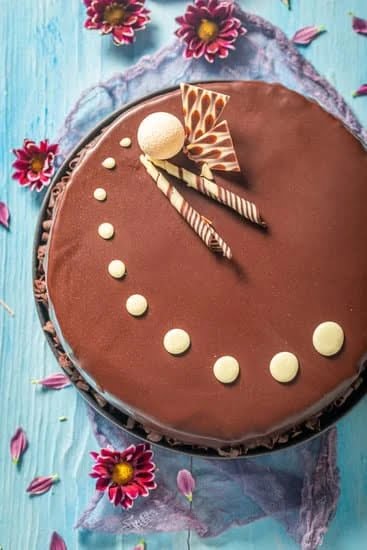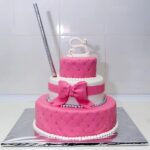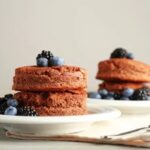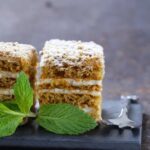Cake decorating borders are the finishing touch that adds flair and elegance to any cake design. These delicate and intricate details showcase the artistry and skill of the decorator, taking a simple cake from ordinary to extraordinary.
In this article, we will explore the world of cake decorating borders – from understanding their importance to exploring different types and designs. Whether you are a beginner or an experienced decorator, this comprehensive guide will provide you with step-by-step techniques, tips, and tricks to master the art of cake decorating borders.
Decorating borders play a crucial role in enhancing the overall aesthetic appeal of a cake. Not only do they create a polished and professional finish, but they also serve practical purposes such as hiding imperfections or uneven edges. Understanding the importance of these borders is essential for any aspiring decorator who aims to elevate their cakes to another level.
Throughout this article, we will delve into different types of cake decorating borders, exploring a wide range of possibilities. From classic designs like shells and pearls to intricate piping patterns and floral arrangements, there is no shortage of inspiration when it comes to creating beautiful borders for your cakes.
Whether you have experience with cake decorating or are just starting out on your creative journey, mastering the technique of cake decorating borders requires practice and patience. In the next section, we will provide you with a step-by-step guide that will walk you through each stage of creating flawless borders. So let’s dive in and discover how to unleash your creativity with stunning cake decorating borders.
Understanding the Importance of Cake Decorating Borders
Cake decorating borders may seem like a small detail, but they play a crucial role in enhancing the overall appearance and presentation of a cake. Understanding the importance of cake decorating borders can help elevate your skills as a decorator and take your cakes to the next level.
First and foremost, cake decorating borders provide a visual frame for the design on your cake. They define the edges and create a clean, polished look. Without a border, the design can appear incomplete or unfinished. Borders help give structure to your cake, making it visually appealing and professional.
Additionally, cake decorating borders serve practical purposes as well. They can act as a barrier to prevent fillings or frosting from spilling over the sides of the cake. This is particularly important when working with softer fillings or delicate designs that require precision.
Understanding the importance of cake decorating borders also involves considering the overall theme or occasion of the cake. Borders can be used to tie in with the theme or color scheme, enhancing the visual cohesiveness of the design. For example, a wedding cake with an elegant lace border can add a touch of sophistication to the overall look.
To create stunning cake decorating borders, it is essential to master different techniques and designs. Whether you opt for classic buttercream piping, fondant accents, or intricate royal icing work, each style contributes to the overall aesthetic appeal of your creation.
Types of Cake Decorating Borders
When it comes to cake decorating, borders play a crucial role in adding that finishing touch and giving the cake a polished and professional look. There are numerous types of cake decorating borders that can be used to enhance the overall appearance of a cake. In this section, we will explore the possibilities of different types of cake decorating borders that can be created.
One popular type of cake decorating border is the buttercream ruffle border. This border involves using a piping bag fitted with a petal tip to create elegant ruffles around the edges of the cake layers. This technique adds texture and dimension to the cake and can be used on various occasions, from weddings to birthdays.
Another variety is the fondant rope border which is created by rolling out strips of fondant into long ropes. The ropes are then twisted or braided together before being attached to the bottom edge of the cake. This border design provides a clean and sleek look, making it perfect for formal events or sophisticated celebrations.
For those who prefer a more whimsical style, the piped bead border is an excellent choice. This border involves using a small round piping tip to pipe small beads of buttercream along the edges of the cake layers. It adds a playful and festive touch to any cake, making it suitable for children’s birthday parties or fun-themed events.
These are just a few examples of the many possibilities when it comes to cake decorating borders. The type of border chosen depends on personal preference as well as the theme and style of the occasion. By exploring different techniques and experimenting with various designs, you can create unique and stunning borders that will make your cakes stand out.
Step-by-Step Guide
Mastering the technique of cake decorating borders is essential for creating a polished and professional-looking cake. Whether you are a beginner or an experienced baker, following a step-by-step guide can help you learn and perfect this skill. Here is a detailed breakdown of the process:
- Prepare Your Cake: Before you begin decorating your cake, make sure it is properly cooled and leveled. It should also be crumb-coated with a thin layer of frosting to create a smooth base.
- Choose Your Piping Tip: There are various piping tips available for creating different border designs. Some popular options include round tips for simple borders, star tips for textured borders, and petal tips for ruffle borders. Select the tip that best suits your desired design.
- Fill Your Piping Bag: Fit your piping bag with the chosen tip and fill it with your desired frosting or icing color. Make sure to twist the top of the bag tightly to prevent any leakage.
- Practice Pressure Control: Hold the piping bag at a 45-degree angle above the cake, making contact with its surface. Apply steady pressure to control the flow of icing as you pipe the border. Practice maintaining consistent pressure to create even lines.
- Start Piping: Begin by applying slight pressure and start piping along the edge of the cake in a continuous motion. Slowly move around the cake’s perimeter while keeping an even distance from it.
- Achieve Uniformity: To achieve uniformity in your border design, try counting seconds while piping each section of the border or use marking techniques as visual guides.
- Finishing Touches: Once you have completed piping around the entire cake, stop applying pressure on the piping bag but continue moving it slightly forward before lifting it away to ensure clean edges.
Remember that practice makes perfect when it comes to mastering cake decorating borders. Start by experimenting with basic designs before advancing to more intricate ones.
With this step-by-step guide, you can develop your skills and create beautifully decorated cakes that are sure to impress.
Popular Cake Decorating Border Designs
Cake decorating borders offer a fantastic opportunity to let your creativity shine and add a personal touch to your cake designs. With a wide range of border designs available, you can explore various styles and techniques to create stunning cake decorations. In this section, we will delve into some popular cake decorating border designs that will inspire you to experiment and unleash your creativity.
One popular cake decorating border design is the scalloped border. This classic design features evenly spaced semi-circular shapes along the edge of the cake. Scalloped borders can be created using various techniques such as piping with a round tip or using fondant cutters. You can also add additional embellishments such as pearls or dragees to enhance the overall look.
Another trendy cake decorating border design is the ruffled border. This design adds a delicate and feminine touch to cakes, making it perfect for weddings and special occasions. Ruffled borders can be created by piping rosettes or frills using a petal tip or by using fondant strips that are pleated or gathered. Experimenting with different colors and textures can further elevate the beauty of ruffled borders.
For those looking for a more modern and minimalist approach, the geometric border design is an excellent choice. This design utilizes clean lines and geometric shapes such as squares, triangles, or diamonds to create a contemporary look. Geometric borders can be achieved by piping straight lines or by using stencils for more precise patterns.
| Border Design | Description |
|---|---|
| Scalloped Border | An elegant design featuring evenly spaced semi-circular shapes. |
| Ruffled Border | A delicate and feminine design created with rosettes or gathered fondant strips. |
| Geometric Border | A modern and minimalist design utilizing clean lines and geometric shapes. |
Remember, these are just a few examples among many possibilities. Feel free to combine different designs, experiment with various techniques, and add your own unique twist to create cake decorating borders that reflect your personal style and elevate the overall presentation of your cakes.
Tips and Tricks for Perfect Cake Decorating Borders
Decorating borders on cakes can be a beautiful and intricate addition to any cake design. They can add a finishing touch, tie together the overall look, and even hide imperfections. However, achieving perfect cake decorating borders requires some tips and tricks to ensure a flawless result.
Choosing the Right Consistency
One of the most important factors in creating perfect cake decorating borders is getting the icing consistency just right. The icing should be firm enough to hold its shape but still soft enough to easily pipe through a pastry bag. If the icing is too stiff, it will be difficult to pipe smooth lines, while if it’s too soft, it may not hold its shape and appear messy.
A great way to test if your icing has the right consistency is by doing a practice pipe on parchment paper or a spare piece of cake. Adjusting the consistency by adding more powdered sugar for stiffness or a tiny amount of water for softening can make all the difference in achieving crisp and clean borders.
Piping Techniques for Borders
Mastering different piping techniques is another key aspect of creating perfect cake decorating borders. The choice of piping tip and technique will vary depending on the desired border design. For simple straight line borders, a round or star tip can be used with consistent pressure applied while moving in uniform motion around the edge of the cake.
For more intricate designs like scallops or ruffles, using specialty tips such as petal or leaf tips can create stunning effects. These techniques often require different movement patterns and varying pressure during piping.
Freezing Technique for Sharp Edges
If you desire sharp edges on your cake borders, try using the freezing technique. Once you have piped your border onto your cake, place it in the freezer for about 10-15 minutes until the icing has hardened slightly. This will help retain the straight lines and sharp edges when you remove the cake from the freezer and complete any additional decorations.
Remember to handle the cake carefully while it’s frozen to avoid any smudging or ruining the finished look. Also, ensure that your icing can withstand freezing before using this technique.
With these tips and tricks in mind, you’ll be well on your way to consistently creating perfect cake decorating borders. Don’t be afraid to experiment with different techniques and designs to add your own unique touch to any cake creation.
Tools and Supplies
Cake decorating borders require the use of specific tools and supplies to achieve the desired effects. Having the right equipment can make the process easier and help you create professional-looking designs. Here are some essential tools and supplies for cake decorating borders:
Piping Bags
Piping bags are a necessity for cake decorating borders. They come in various sizes and materials, such as disposable plastic or reusable cloth. It’s important to choose a piping bag that feels comfortable in your hand and allows for easy control of the icing flow. Disposable bags are convenient for one-time use but often lack durability, while reusable bags are more sustainable and built to last.
Piping Tips
Piping tips are interchangeable attachments that fit onto the end of a piping bag. They determine the shape and size of the border design. There is a wide variety of piping tips available, each producing different patterns like stars, shells, ropes, or ruffles. It’s recommended to have a selection of basic tips on hand, such as round, star, petal, and leaf tips, to cover a range of border designs.
Icing Spatulas
Icing spatulas are essential for smoothing out frosting on cakes before applying borders. Offset spatulas are particularly useful as they allow you to reach difficult angles without getting your hand in the way. This helps achieve even and precise frosting application.
Turntable
A turntable is not only useful for cake display purposes but also makes it easier to decorate borders evenly around the circumference of the cake. By rotating the cake as you work, you have better control over your piping consistency.
Food Coloring
Food coloring is necessary if you want to add color accents to your cake borders. Gel-based food coloring is highly recommended as it provides vibrant colors without diluting your frosting consistency.
Remember that proper maintenance and cleaning of your tools are important for longevity. Ensure that you wash and dry your equipment thoroughly after each use to prevent them from deteriorating or affecting the quality of your border designs. With the right tools and supplies, you can create beautiful and professional cake decorating borders that will make your creations truly stand out.
Showcasing Cake Decorating Borders
Cake decorating borders are not only a finishing touch to a beautifully baked cake, but they also serve as a way for professionals to showcase their creativity and skill. In this section, we will explore some inspiring examples of cake decorating borders created by professionals in the industry. From elegant and intricate designs to whimsical and fun creations, these examples will surely spark your imagination.
One popular cake border design that professionals often use is the shell border. This border is created by piping small shell shapes in a continuous line around the edge of the cake. It adds a classic and elegant touch to any cake design and can be done using buttercream or royal icing. The shell border can be created with different sizes of shells, allowing for variation in design.
Another stunning example of a cake decorating border is the lace border. This delicate design mimics the look of lace fabric draped over the edge of the cake. It requires intricate piping skills and attention to detail to achieve a realistic lace effect. The lace border can be used on wedding cakes or any other special occasion cakes where an extra touch of elegance is desired.
For those looking for a more playful and whimsical approach to cake decorating borders, there are endless possibilities. Professionals often use techniques such as creating polka dots, zigzags, or even floral designs using various piping tips and techniques. These borders add fun and personality to cakes, making them perfect for birthdays or themed events.
| Cake Decorating Border Design | Description |
|---|---|
| Shell Border | A classic and elegant border design created by piping small shell shapes in a continuous line around the edge of the cake. |
| Lace Border | An intricate design that mimics the look of lace fabric draped over the cake, adding a touch of elegance to any special occasion cake. |
| Whimsical Designs | Playful and fun designs such as polka dots, zigzags, or floral patterns created with various piping techniques and tips. |
Troubleshooting Common Issues
Decorating a cake can be both rewarding and challenging. While cake decorating borders can add a beautiful finishing touch to your creations, it can also come with its fair share of mistakes. But fear not, as this section will provide you with valuable tips and tricks on how to troubleshoot common issues and fix cake decorating border mistakes.
One common issue that many bakers face when creating cake decorating borders is uneven piping. Uneven borders can make the whole design look sloppy and less professional. To fix this issue, start by ensuring that your piping bag is properly filled and that the icing consistency is correct.
If the icing is too thin, it may cause the border to spread unevenly. On the other hand, if the icing is too thick, it may be difficult to pipe smoothly. Adjusting the consistency of your icing and practicing steady pressure while piping can help you achieve more even borders.
Another problem that often arises in cake decorating borders is air bubbles or breakage in the piped design. This can be frustrating, especially when you’ve spent a significant amount of time working on a delicate border pattern. To avoid this issue, make sure to eliminate any trapped air bubbles in your piping bag before starting.
Gently tap the bag against a flat surface or squeeze out any excess air before beginning to pipe. Additionally, it’s important to allow each layer of icing to dry before adding another layer on top to prevent breakage.
Lastly, an issue that many beginners encounter when creating cake decorating borders is inconsistent spacing between piped designs or patterns. This can make the overall appearance of the border appear sloppy or haphazard. To overcome this problem, consider using guidelines or marking out equal spacing on your cake beforehand using edible markers or toothpicks. Having a visual guide will help ensure consistent spacing between each piped design.
Conclusion
As you can see, cake decorating borders are not just a simple finishing touch on a cake. They have the power to elevate your creations to a whole new level of beauty and artistry. Understanding the importance of cake decorating borders and exploring the various types available will allow you to unleash your creativity and create stunning designs that will leave everyone in awe.
With the step-by-step guide provided, mastering the technique of cake decorating borders becomes much more attainable. By following these instructions, you can confidently create intricate borders that will impress even the most discerning cake lovers. Additionally, incorporating popular cake decorating border designs will give you endless possibilities for customization and personalization.
While perfecting your technique is essential, it’s also important to keep in mind some tips and tricks that can make the process even easier and more efficient. From choosing the right tools and supplies to troubleshooting common issues, these suggestions will ensure that your cake decorating borders turn out flawless every time.
Lastly, showcasing some examples from professionals in the industry gives us a glimpse into what can truly be achieved with cake decorating borders. These inspiring examples prove that by taking your time, practicing diligently, and allowing yourself to think outside of the box, you have the potential to create exquisite works of edible art.
In conclusion, with this newfound knowledge about cake decorating borders, there is no limit to what you can achieve. Elevate your cakes with stunning decorating borders and watch as they become showstoppers at any event or gathering.
Let your creativity shine through and enjoy the process of transforming ordinary cakes into extraordinary masterpieces that will leave a lasting impression on all who see them. So go ahead, grab your tools and get ready to embark on an exciting journey into the world of cake decorating borders.
Frequently Asked Questions
How to decorate a cake border?
Decorating a cake border requires careful attention to detail and creativity. There are many techniques you can use to achieve a beautiful and elegant cake border. One popular method is using buttercream frosting to pipe designs onto the border of the cake.
You can use different piping tips to create various shapes and patterns, such as rosettes, shells, or swirls. Another option is adding decorative elements like fondant cutouts or edible flowers along the side of the cake. When decorating a cake border, it’s important to consider the overall theme and style of the cake in order to create a cohesive and visually appealing design.
What piping tips are best for cake border?
When it comes to choosing the best piping tips for cake borders, it ultimately depends on your desired design and level of intricacy. Some commonly used piping tips for creating borders include: round tips (such as #3 or #5) which are great for creating simple dots; star tips (like #16 or #21) that can be used to create rosettes or small shell designs; petal tips (such as #104) that allow you to pipe delicate flower petals along the border; and leaf tips (like #352) that are perfect for adding realistic leaf accents.
The best piping tip will depend on your personal preference and the specific design you want to achieve for your cake border.
How do you pipe a bead border on a cake?
Piping a bead border on a cake can add an elegant finishing touch to your creation. To achieve this technique, start with a piping bag fitted with a round tip (around size #3 or #4). Fill the bag with buttercream frosting or royal icing, ensuring that there are no air bubbles inside. Hold the piping bag at around 45-degree angle towards the surface of the cake, making sure it touches but does not sink into the cake’s surface.
Gently apply even pressure to release small beads of frosting from the tip, guiding it along in a continuous motion around the cake. Keep the distance between each bead consistent to create a neat and uniform border. Once you have completed piping the bead border, you can leave it as is or further enhance it by adding small pearls or sprinkle decorations. Practice and patience are key to achieving a clean bead border, so take your time and enjoy the process.

Welcome to our cake decorating blog! My name is Destiny Flores, and I am the proud owner of a cake decorating business named Cake Karma. Our mission is to provide delicious, beautiful cakes for all occasions. We specialize in creating custom cakes that are tailored specifically to each customer’s individual needs and tastes.





